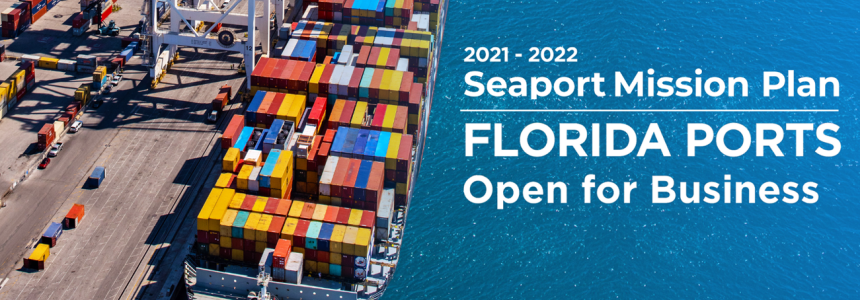News & Updates
New Seaports Report Shows Florida’s Ports Well-Positioned To Take Advantage of Realignment in Global Trade Routes

Florida’s “Open for Business” Strategy Answering Supply Chain Demands
TALLAHASSEE, Fla. (July 13, 2022) – Strong investments in Florida’s 15 seaports have well-positioned Florida to answer supply chain demands, and take advantage of a realignment in global trade routes, a new report shows. The Seaport Mission Plan, Florida Ports: Open for Business, released by the Florida Seaport Transportation and Economic Development Council (FSTED), provides an analysis on the health and capabilities of Florida ports, as well as trends on the horizon.
The report comes as 29 West Coast ports are working without a negotiated labor contract, and many shippers have already changed lanes to reroute to East Coast ports in fears that 2022 labor negotiations could lead to similar strikes, lockouts and slowdowns that occurred in 2002, 2008, 2012 and 2014.
“Florida’s continued investment in our seaports have made it a destination for companies from around the world frustrated with the logjams at Pacific coast ports,” said Governor Ron DeSantis. “We will continue to make the investments necessary to bolster our supply chain and improve our infrastructure to bring more business to Florida’s seaports.”
“Florida’s seaports are flexing their muscles, and seizing the opportunity to become a global hub by capturing an even larger share of international trade and related commercial activities,” said Michael Rubin, FSTED Program Administrator.
Indeed, since the unprecedented economic and supply chain upheaval caused by the pandemic, it’s clear that Florida ports can support current demand and grow into the future, the report says.
Further, Florida’s strong performance has resulted in global shipping lines changing trade lanes to specifically call on Florida ports – this includes new direct Asia services. Chief among the new lines of business recently secured are:
- The first vessel in global ocean carrier Sea Lead Shipping Pte Ltd’s new Asia East Coast container service making its inaugural call to JAXPORT in June.
- A new direct Asia service is now calling on Port Tampa Bay, and new service connections with Mexico and Central America have been secured.
- MSC has launched its new Zephyr service from northern China and South Korea to the U.S. Gulf Coast, and it includes a direct call to Port Everglades.
Highlights from the 2022 Seaport Mission Plan include:
- Total tonnage (inbound and outbound) increased 118.4 percent year-over-year.
- Liquid bulk cargo accounted for 72.9 percent of total waterborne cargo tonnage, up 26 percent over 2020.
- Containerized cargo accounted for the second-highest percentage of total tonnage, up 16.2 percent.
- TEUs: Seaports saw an overall increase of 16.0 percent compared to 2020, exceeding the previous high in 2018 (4.0 TEUs) by some 218,000 TEUs.
- Port Miami recorded its busiest cargo year in history, up almost 18 percent over last year, with most of the additional cargo attributed to imports coming from Asia which would normally go into California.
- Port Tampa Bay container tonnage increased by 14 percent in the first quarter of 2022, with huge jumps in building material. Steel is up 122 percent; lumber is up 160 percent.
- Port Everglades saw 11 percent growth year-over-year, and they are up more than 25 percent year-to-date.
- At SeaPort Manatee, the first quarter of 2022 showed a 15 percent increase in short tons. Wood products, which normally go into California, have been coming to SeaPort Manatee.
- JAXPORT recently celebrated the completion of the Jacksonville Harbor Deepening Project through its Blount Island Marine Terminal to accommodate post-Panamax container ships.
- Port Canaveral’s year-over-year tonnage is up 685,000 tons (29 percent), and two new vessels carrying breakbulk frozen French fries from Belgium, are now calling on the port.
- Port of Palm Beach recorded 37,200 TEUs and 495,976 STONS in increased fourth quarter activity.
- Port Panama City handled an increased volume of forest product exports destined for the Far East, along with metals imports that previously moved in containers through another East Coast Port.
- Cruising began its ascent from COVID-19 in June 2021, and approximately 24.8 million people are expected to cruise in 2022 based on current rates of vessel deployment and passenger capacity percentages.
Port investments have been essential to seaports seizing the opportunity to connect more commerce and strengthen Florida’s economy. Of the $4.5 billion in seaport capital improvements identified over the next five years, 75.1 percent is being made in Atlantic coast seaports, with the remaining 24.9 percent being made by Gulf coast seaports. The largest planned investments are for:
- Cruise Terminals – 30.8%
- Cargo Terminals – 21.8%
- Berth Rehabilitation and Repairs – 19.8%
- Site Improvements – 7.9%
Prepared by FSTED as required by Florida Statute, this annual report provides data on cargo and cruise activities at Florida’s seaports, as well as updated international trade data for Florida.
# # #
ABOUT THE FSTED & THE SEAPORT MISSION PLAN:
Since 1990, FSTED has produced the Seaport Mission Plan (SMP) annually by law. The SMP provides citizens and businesses with a historical accounting of the overall health, capabilities and trends in the important work of Florida’s 15 seaports, and their contribution to Florida’s economy and society.
